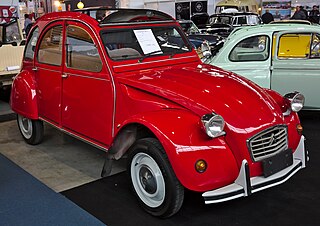Dodge is an American brand of automobiles and a division of Stellantis North America, based in Auburn Hills, Michigan. Dodge vehicles have historically included performance cars, and for much of its existence Dodge was Chrysler's mid-priced brand above Plymouth.

The Citroën 2CV is an economy car produced by the French company Citroën from 1948 to 1990. Introduced at the 1948 Paris Salon de l'Automobile, it has an air-cooled engine that is mounted in the front and drives the front wheels.

A model car, or toy car, is a miniature representation of an automobile. Other miniature motor vehicles, such as trucks, buses, or even ATVs, etc. are often included in this general category. Because many miniature vehicles were originally aimed at children as playthings, there is no precise difference between a model car and a toy car, yet the word 'model' implies either assembly required or the accurate rendering of an actual vehicle at smaller scale. The kit building hobby became popular through the 1950s, while the collecting of miniatures by adults started to gain momentum around 1970. Precision-detailed miniatures made specifically for adults are a significant part of the market since the mid-1980s.

Eagle was a brand of the Chrysler Corporation following the purchase of American Motors Corporation (AMC) in 1987 and marketed through the end of the 1998 model year. It was aimed at the enthusiast driver and promoted as more "European" than the automaker's similar models.

The Lamborghini Countach is a rear mid-engine, rear-wheel-drive sports car produced by the Italian automobile manufacturer Lamborghini from 1974 until 1990. It is one of the many exotic designs developed by Italian design house Bertone, which pioneered and popularized the sharply angled "Italian Wedge" shape.

A concept car is a car made to showcase new styling or new technology. Concept cars are often exhibited at motor shows to gauge customer reaction to new and radical designs which may or may not be produced.

The Hillman Avenger is a rear-wheel drive small family car originally manufactured by the former Rootes division of Chrysler Europe from 1970–1978, badged from 1976 onward as the Chrysler Avenger. Between 1979 and 1981 it was manufactured by PSA Peugeot Citroën and badged as the Talbot Avenger. The Avenger was marketed in North America as the Plymouth Cricket and was the first Plymouth to have a four-cylinder engine since the 1932 Plymouth Model PB was discontinued.

The Oldsmobile Silhouette is a minivan manufactured by General Motors for model years 1990–2004 over two generations.

The Dodge Omni and the nearly identical badge engineered variant, the Plymouth Horizon, is a subcompact car manufactured and marketed by Chrysler Corporation for model years 1978–1990. The first Chrysler model line produced with front-wheel drive, the Omni and Horizon were also the first front-wheel drive economy cars assembled in the United States. Marketed for eleven years with very few changes, around 2,500,000 Omnis and Horizons were manufactured, with the Plymouth variants more popular than the Dodge-branded models.

The Ford Aerostar is a range of vans that was manufactured by Ford from the 1986 to the 1997 model years. The first minivan produced by Ford, the model line was marketed against the Chevrolet Astro/GMC Safari and the first two generations of the Chrysler minivans. Introduced shortly before the Ford Taurus, the Aerostar derived its name from its slope-nosed "one-box" exterior.

Checker Motors Corporation was a vehicle manufacturer, and later an automotive subcontractor, based in Kalamazoo, Michigan. The company was established by Morris Markin in 1922, created by a merger of the firms Commonwealth Motors and Markin Automobile Body, and was initially named the Checker Cab Manufacturing Company. The manufacturer was originally based in Chicago, before moving to Kalamazoo in 1923. The company was renamed Checker Motors in 1958.

The Chrysler PT Cruiser is a compact car that was built by the American company Chrysler from 2001 until 2010. Introduced as a five-door hatchback wagon, a two-door convertible variant was also made from 2005 until 2008.

The BMW Z1 is the first model in BMW's line of Z series roadsters, and was produced in limited numbers from 1989 to 1991.

The Chevrolet HHR is a retro-styled, high-roofed, five-door, five-passenger, front-wheel drive wagon designed by Bryan Nesbitt and launched by the American automaker Chevrolet at the 2005 Los Angeles Auto Show as a 2006 model.

The Stout Scarab is a streamlined 1930–1940s American car, designed by William Bushnell Stout and manufactured by Stout Engineering Laboratories and later by Stout Motor Car Company of Detroit, Michigan.

The Plymouth Prowler, later the Chrysler Prowler, is a retro-styled production sports car manufactured and marketed from 1997 to 2002 by DaimlerChrysler, based on the 1993 concept car of the same name.
Bryan Edward Nesbitt is an automobile designer and currently head of General Motors Corporation International Operations Design, based in Shanghai, China. Nesbitt is also brand chairman for Wuling and Baojun, two automakers with which GM has joint ventures.

The Dodge Intrepid is a full-sized front-wheel drive four-door sedan that was produced by Dodge for the 1993 to 2004 model years. It is related to the Chrysler 300M, Chrysler Concorde, Chrysler LHS, Chrysler New Yorker, and Eagle Vision which were all built on Chrysler's new "cab forward" LH platform.

A sliding door is a type of door that is mounted on or suspended from a track for the door to slide, usually horizontally and outside. It is a feature predominantly found in minibuses, buses, minivans and vans, so as to allow a large unobstructed access to the interior for loading and unloading of passengers or cargo without the doors interfering with adjacent space.
The Ford Carousel is a prototype vehicle that was developed by Ford in 1973. A derivative of the third-generation Ford Econoline/Club Wagon, the Carousel explored a number of the concepts that 1980s American-market minivans later put into production, serving as an alternative to both full-size station wagons and passenger vans.
















